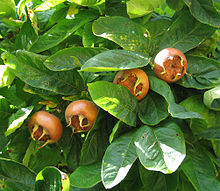Mespilus germanica
| Mespilus germanica | |
|---|---|
 |
|
| Foliage and fruit | |
| Scientific classification | |
| Kingdom: | Plantae |
| (unranked): | Angiosperms |
| (unranked): | Eudicots |
| (unranked): | Rosids |
| Order: | Rosales |
| Family: | Rosaceae |
| Genus: | Mespilus |
| Species: | M. germanica |
| Binomial name | |
|
Mespilus germanica L. |
|
Mespilus germanica, known as the medlar or common medlar, is a large shrub or small tree, and the name of the fruit of this tree. The fruit has been cultivated since Roman times, and is unusual in being available in winter, and in being eaten when bletted. It is eaten raw and in a range of dishes. When the genus Mespilus is included in the genus Crataegus, the correct name for this species is Crataegus germanica Kuntze.
Despite its Latin name, which means German or Germanic medlar, it is indigenous to southwest Asia and also southeastern Europe, especially the Black Sea coasts of Bulgaria and of modern Turkey. It may have been cultivated for as long as 3,000 years. The ancient Greek geographer Strabo refers to a μέσπιλον (mespilon) in Geographica, book 16, Chapter 4.
Until recently, Mespilus germanica was the only known species of medlar. However, in 1990, a new species was discovered in North America, now named Mespilus canescens. The loquat, Eriobotrya japonica, is more distantly related than genera such as Crataegus, Amelanchier, Peraphyllum, and Malacomeles, but was once thought to be closely related, and is still sometimes called the 'Japanese medlar'.
From an extensive study of literature and plant specimens, Kazimierz Browicz concluded that the
true homeland [of Mespilus germanica] is only in the south-eastern part of the Balkan peninsula, in Asia Minor, on the Caucasus, Crimea, northern Iran and possibly also in Turkmenia.
Mespilus germanica requires warm summers and mild winters and prefers sunny, dry locations and slightly acidic soil. Under ideal circumstances, the deciduous plant grows up to 8 metres (26 ft) tall. Generally, it is shorter and more shrub-like than tree-like. With a lifespan of 30–50 years, the medlar tree is rather short-lived. Its bark is greyish brown with deep vertical cracks forming rectangular plates that tend to lift off. The leaves are dark green and elliptic, 8–15 centimetres (3.1–5.9 in) long and 3–5 centimetres (1.2–2.0 in) wide. The leaves are densely hairy (pubescent) below, and turn red in autumn before falling. It is found across Southern Europe where it is generally rare. It is reported to be naturalized in some woods in Southeast England, but is found in few gardens.
...
Wikipedia
